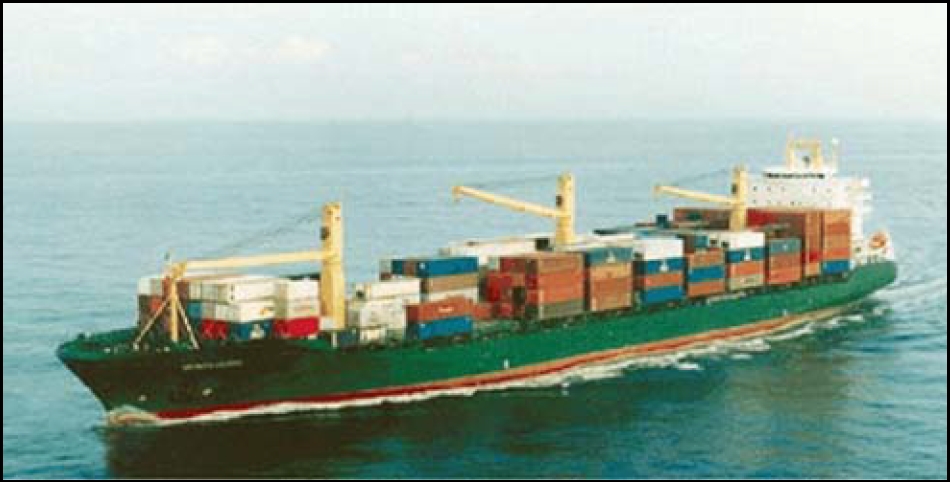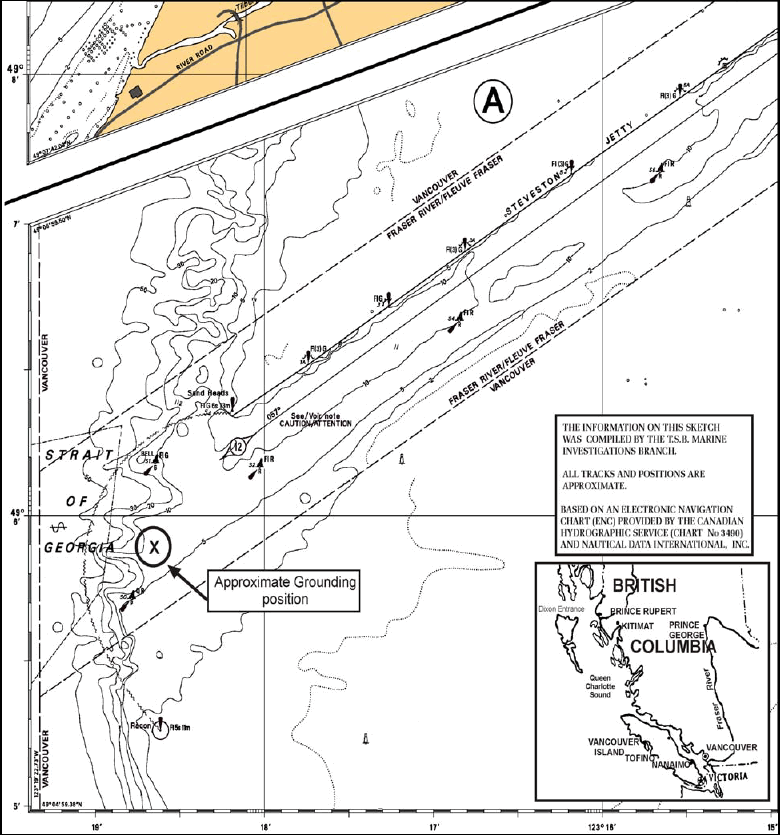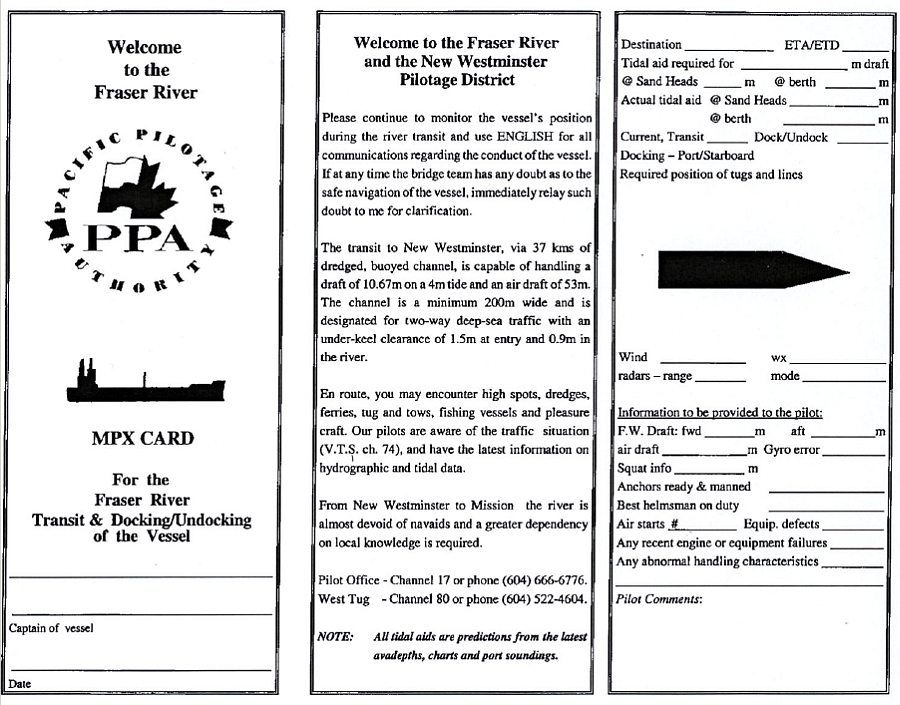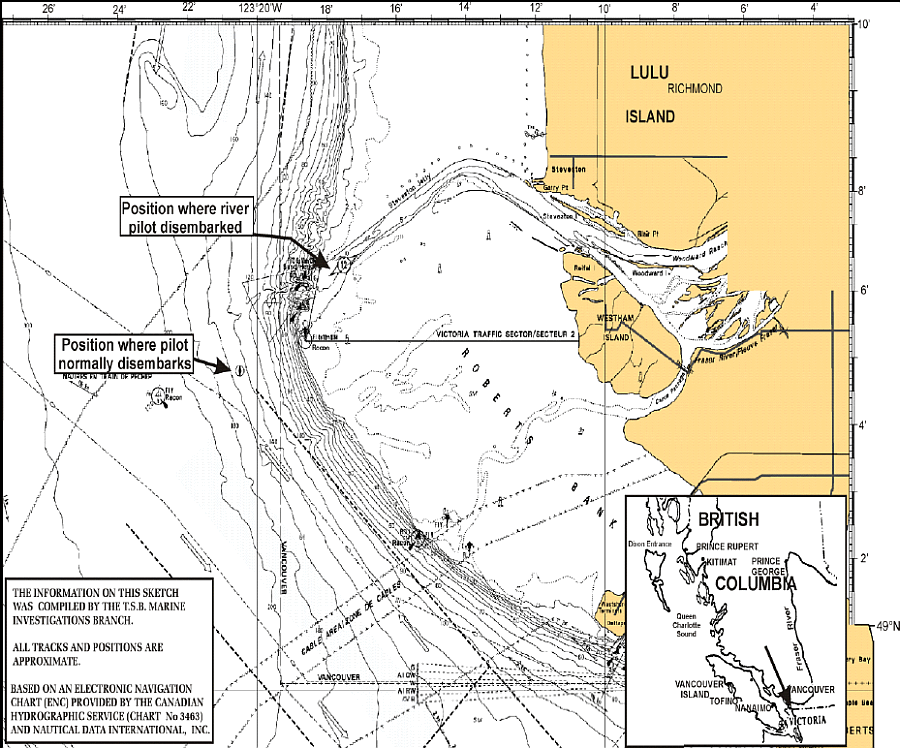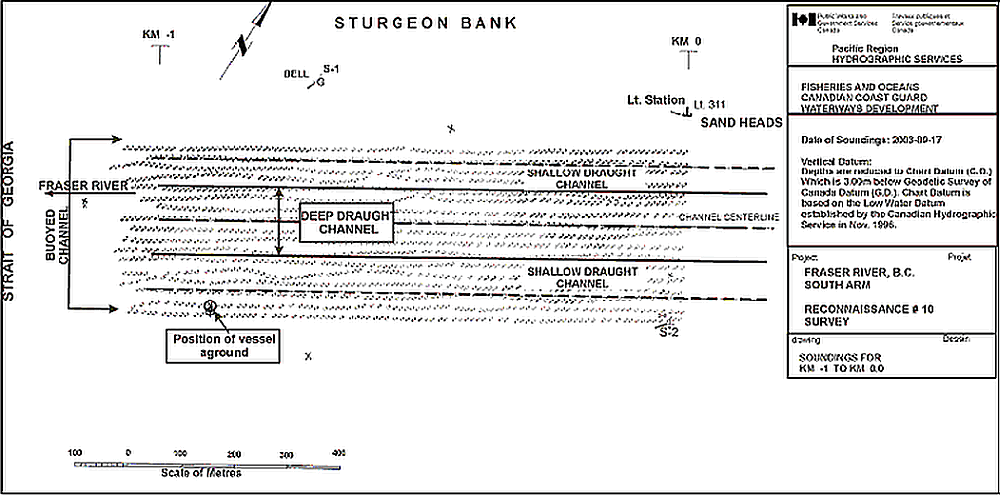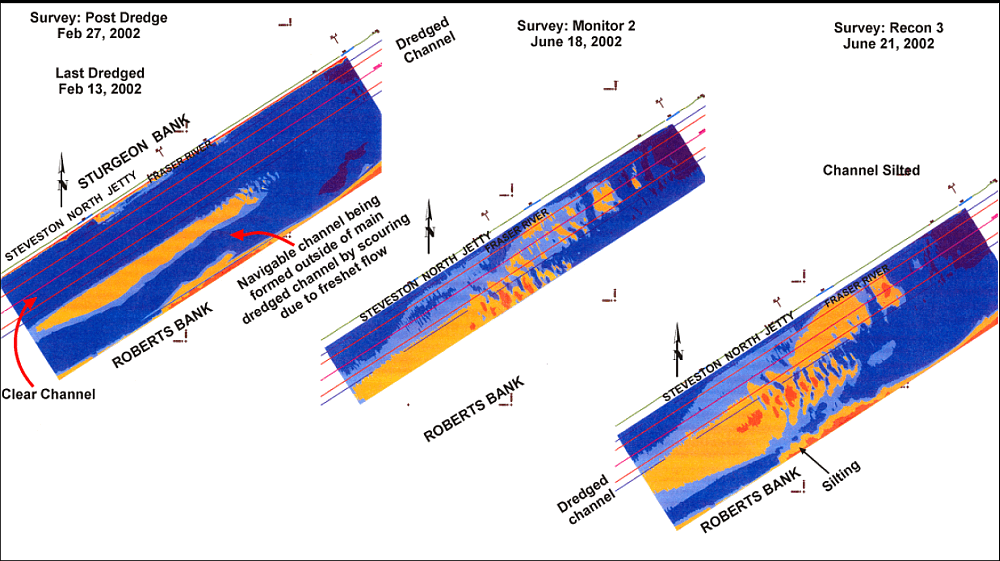Grounding
Container vessel Cielo del Canada
Fraser River, British Columbia
The Transportation Safety Board of Canada (TSB) investigated this occurrence for the purpose of advancing transportation safety. It is not the function of the Board to assign fault or determine civil or criminal liability. This report is not created for use in the context of legal, disciplinary or other proceedings. See Ownership and use of content. Masculine pronouns and position titles may be used to signify all genders to comply with the Canadian Transportation Accident Investigation and Safety Board Act (S.C. 1989, c. 3).
Summary
At 0828, 08 November 2003, the container vessel Cielo del Canada, while outbound from Fraser Surrey Docks, under the conduct of a British Columbia coast pilot, ran aground between buoys S0 and S2, on a falling tide, while still within the marked buoyed channel.
The vessel was refloated on the rising tide with the assistance of tugs, and redocked at Fraser Surrey Docks. An underwater survey carried out while the vessel was alongside revealed no apparent damage to the vessel's bottom structure.
Factual information
Particulars of the vessel
| Name | "CIELO DEL CANADA" |
|---|---|
| Official number | SSR 4872 |
| Port of registry | Leer |
| Flag | Germany |
| Type | Container Vessel |
| Gross tonsFootnote 1 | 25 361 |
| Length | 207.34 m |
| Draught | Forward: 10.15 m Aft: 10.25 m |
| Built | Nov. 1998, Wismar, Germany. |
| Propulsion | 6 cyl. Diesel engine, 17 220 kW, one fixed-pitch propeller. |
| Cargo Capacity | 2470 TEUFootnote 2 |
| Cargo | 874 containers |
| Crew members | 18 and 2 supernumeraries |
| Passengers | none |
| Owner | Hermann Buss GmbH & Co. KG |
Description of the vessel
The 2470 TEUFootnote 2 container vessel has five holds with the crew accommodation and engine-room space located aft of the Number 5 hold. It has three cranes that are utilized primarily for cargo operations. The wheelhouse structure is offset to starboard from the centre line. This is to negate the blind sector effect caused by the cylindrical steel vertical pillars along the centre line that house the cranes.
Fraser Port
The Fraser River Port Authority has jurisdiction within its defined harbour limits, which extend from the mouth of the South Arm of the Fraser River, near Sand Heads to Kanaka Creek in Maple Ridge, but excludes the North and Middle Arms. The deep-sea berths on the river are mainly used for forest products, general cargo, automobiles and bulk shipments; depths alongside range from 4.6 to 11.6 m.
History of the voyage
- At 0618Footnote 3 on 08 November 2003, the Cielo del Canada departed Fraser Surrey Docks, outbound for Oakland, California, U.S.A. There was both a Fraser river pilot and a British Columbia coast pilot on board. Weather conditions were fine and clear with rippled waters.
- The passage to the entrance to the Fraser River where the pilot exchange is carried out is approximately 20 nautical miles and takes about 2 hours.
- Prior to departure, the master and the river pilot discussed the vessel's undocking procedure.
- The coast pilot entered the wheelhouse at buoy S6, to familiarize himself with the position of the vessel, its navigational equipment, and the traffic within the immediate area and at the approaches to the river.
- The river pilot was keeping the vessel in the middle of the buoyed channel using the range lights.
- The handover took place within the designated compulsory pilotage area for the river pilot.
- Immediately after the hand over, the river pilot left the wheelhouse and, assisted by the officer of the watch, proceeded to the pilot ladder to disembark.
- The helmsman and the coast pilot were in the wheelhouse, as the master supervised the disembarking of the river pilot from the starboard bridge wing. The speed was reduced to dead slow ahead to facilitate the transfer of the river pilot to the pilot boat.
- While the master and officer of the watch were so engaged, and while proceeding at a reduced speed, the vessel began sheering to port. The pilot requested starboard helm and slow ahead on the engines to counteract the swing. However, at 0828 the vessel ran aground on a soft ledge while still within the buoyed channel, between buoys S2 and S0, in position 49°05′55″ north, 123°18′39″ west. At the request of the coast pilot, the river pilot returned to the vessel and assisted with the refloating.
- The Cielo del Canada was deballasted and with the assistance of tugs was refloated at 1254, approximately 4½ hours later, on the rising tide.
- The vessel proceeded out of the river, where at 1342 the coast pilot disembarked. There was an exchange of river pilots before returning to the Fraser Surrey Docks at 1640, for an underwater survey and to load more containers.
- The underwater survey carried out while the vessel was alongside revealed no apparent damage to the vessel's bottom, and a Transport Canada inspector gave the vessel clearance to continue on its voyage.
Certification
Vessel
The Cielo del Canada was certified in accordance with existing regulations.
The vessel held a valid Safety Management System certificate in accordance with the International Management Code for the Safe Operation of Ships and for Pollution Prevention.
Personnel
The master, officers and crew of the vessel held certification appropriate for the class of vessel on which they were serving and for the intended voyage.
The master had 25 years of command experience on deep-sea vessels and this was his fourth consecutive trip into the Fraser River, during his current contract on this vessel.
The helmsman, at the time of the occurrence, was an apprentice who was 2½ years into his three-year apprenticeship tenure.
Pilots
The Fraser River pilot held a Master Home Trade under 350 tons certificate of competency and a valid Pilot's licence for the area in question (Pacific Pilotage District, Compulsory Pilotage Area 1). He has been a pilot on the Fraser River since 1980.
The British Columbia coast pilot held a Master Home Trade under 350 tons certificate of competency and a valid pilot's licence for the British Columbia coast (Pacific Pilotage District, Compulsory Pilotage Area 2 through 5). The areas for which he was licensed, however, did not include the occurrence location. At the time of the occurrence, he had been a British Columbia coast pilot for 5½ years.
Weather and current information
The weather was clear, with light northerly winds at 8 knots and good visibility.
The Canadian Hydrographic Service (CHS) Tide and Current Tables, Volume 5, predicted the time of high water at Point Atkinson (the closest reference port) to be at 0545, with a height of 4.3 m above chart datum, and the next low water to be at 1105 with a height of 3.0 m. At the time of the grounding, the tide was ebbing. The height of tide was approximately 3.66 m above chart datum and falling.
The CHS also predicted the surface current to be setting in a southerly direction at rates varying between 1.5 knots at buoy S4 and 0.4 knots at the grounding position.
CHS Chart No. 3490 indicates the depth in the vicinity of the grounding as being 6.7 m at chart datum.
Speeds and grounding sequence
The vessel was proceeding at an estimated speed of 10 knots with the engine on slow ahead until immediately before the river pilot disembarked, at which time dead slow ahead was selected. Dead slow ahead is considered the optimal speed required by the pilot boat for pilot disembarkation.
It was estimated that the vessel was doing a speed of 4.6 knots at the time of grounding. The coast pilot was aware that there was a southerly set in the area and he anticipated that the helmsman would apply a sufficient helm to counteract any swing. The pilot eventually ordered 20° starboard helm followed by slow ahead, however, it was too late to counteract the swing. As the master came in from the bridge wing, the bow of the vessel rose slightly as it touched a soft ledge. Half ahead was selected, followed by full ahead, to slide the vessel over the ledge, but the vessel did not move and came to rest, aground on a heading of 237° True. This was followed by various engine and helm manoeuvres in an attempt to free the vessel.
Bridge Resource Management
Prior to departure, under the Bridge Resource Management procedures, the exchange of information between the river pilot and the master were limited to undocking procedures. No passage plan was discussed, neither was the coast pilot involved in passage planning.
During the river passage the master relied solely on the expertise of the river pilot and there was very little interaction between the vessel's bridge team and the RP. Although the vessel's position was being monitored by the officer of the watch, positions were not being plotted on the chart.
The handover briefing between the river pilot and the coast pilot was minimal, and salient information on current, channel width and depths was not exchanged.
Pilot handover location
The official charted handover position for the exchange of pilots is approximately 1.8 miles southwest of Sand Heads lighthouse.
There is conflicting information as to the exact location where the handover took place. According to one source, the handover took place between buoys S2 and S4, whereas according to another source the handover took place while the vessel was abeam of Sand Heads lighthouse. In any event, the handover of the vessel took place within the designated compulsory pilotage area for the river pilot while the vessel was still within the buoyed channel.
The river pilot is licensed to pilot vessels on area 1, which includes the Fraser River and an area that extends beyond river-entrance buoys S0 and S1, into the Straits of Georgia, and overlaps with Area 2. The coast pilot, on the other hand, is licensed in Area 2 but, explicitly, not east of a line roughly following a north/south axis that almost intersects the entrance buoys S0 and S1.
Silting/scouring within the river
The Fraser River is at its lowest levels during January, February and March. As snow begins to melt inland in April, the river rises, reaching its peak in June, and fluctuates within the higher levels until mid-August. The water brings with it approximately 32 million cubic metres of sediment each year, of which approximately 2 million cubic metres is deposited within the shipping channels of the Fraser River. Depths are continually changing with some geographical locations experiencing more heavy silting than others. The clearing action of the swift current in the river also causes scouring, whereby, during peak run-offs, there is significant infill in the channel. Deep-water channels are created closer to the bank, outside of the main dredged shipping channel, and, on occasion, the pilots use these newly formed deep-water channels.
The critical points that silt along the river between km 0 (the mouth of the Fraser River) and km 35 (Fraser Surrey Docks) are Sand Heads Reach (between buoys S8 and S0), Steveston Bend, Steveston Cut, S23 buoy, Tilbury Bend S28, S32 buoy, Alex Fraser Bridge and Fraser Surrey Docks.
A bar, south of the main dredged channel between buoys S2 and S0, had been steadily building up over the three years prior to the occurrence and had been gradually extending out to the main navigable dredged channel.
Channel design
The channel is dredged and maintained in accordance with the Guidelines for the Safe Design of Commercial Shipping Channels and Canadian Waterways National Manoeuvring Guidelines: Channel Design Parameters. These conform to the PIANCFootnote 4 standards, which allow for a reduction of 20 percent in the manoeuvring lane width, provided that "the navigation aids are good or... a pilot is available."
The Canadian Coast Guard (CCG) establishes minimum standard guidelines for the design parameters and boundaries of the main navigation channels on the Fraser River. The design is based on the needs of the river users, and the location and type of shipping and port activities on the river. To this end, the CCG has designed a two-way navigable channel with a width varying from 200 m to 300 m and a maintained channel depth of 10.7 m, using tidal assistFootnote 5 from Sand Heads (km 0) to Port Mann Bridge (km 42 ).
The parameters are based on a transit of a "design vessel," having the characteristics of an ocean-going cargo ship of PanamaxFootnote 6 class, of length 228.6 m, 32.3 m beam, 10.67 m draft. The channel depth is intended to provide the designed vessel with a 2 hour transit opportunity (with tidal assist ) 95 percent of the days in any year.
Main shipping channel and dredged widths
The width of the buoyed channel in the South Arm of the Fraser River varies between approximately 250 m and 310 m. The last stretch of the river while outbound, between buoys S8 and S2, is approximately 310 m wide.
Following along the minimum standard guidelines established by the CCG, the Fraser River Port Authority maintains a dredged channel for deep-sea shipping as follows:
- an outer channel for vessels with a maximum draught of 10.7 m, which is maintained to a width of 200 m to 250 m; and
- an inner channel for deeper draught vessels up to 11.5 m draught, which is maintained to a width of 13 m to 170 m.
Sounding surveys/field charts and dredging operations
A sounding and dredge plan is made for the year, and critical areas prone to frequent silting are dredged more often. Dredging is, however, severely restricted from March 01 until mid-June to protect/conserve fish habitats within the river and to avoid damage to the dredging equipment during peak run-offs, due to the rapid rate of the water flow.
As the river slows down after the peak run-off, it is difficult to keep up with the sediment that is deposited within the various sections of the river. The river bed changes constantly and rapidly, with critical sections of the navigable channel silting within 48 hours.
Surveys are conducted by Public Works and Government Services Canada, and the Fraser River Port Authority maintains the dredged channel. The frequency of these surveys is dependant on the rate/stage of the river flow, and this is assessed by the discharge rate at Hope. Field Charts for the use of the river pilots are usually produced and dispatched to them within 36 hours of the surveys.
The data sheet showing the river depths at the site of the grounding of the Cielo del Canada, used by the river pilot on 08 November 2003, was based on a survey conducted on 17 September 2003. The depths shown around the grounding site are between 6.2 to 6.3 m above chart datum.
Information in the sailing directions and CHS Chart No. 3490
The Sailing Directions -British Columbia Coast (South Portion),Footnote 7 state:
DEPTHS - Because of continual changes in the depths of the Fraser River as a result of silting, scouring and dredging, the charts may not show the latest conditions. Surveys are conducted by Public Works Canada.
Dredging is also carried out at the wharves in Fraser Port. For up-to-date information, particularly when a critical draught is concerned, the owners of the wharf should be contacted.
CHS chart 3490, Fraser River, has the following cautionary note :
Mariners are advised the depths shown on this chart are subject to change as a result of silting, scouring or dredging.
Scheduling of arrivals/departures for deep-sea vessels
The daily arrival and departure parameters for every deep-sea vessel entering/departing the Fraser Port is calculated in advance by a committee of pilots from the Pacific Pilotage Authority. The committee's calculation is based on a Schematization of the Fraser River Model, a booklet that is put out each year by CHS. A time window is calculated within which a vessel, with a predetermined draught, is able to transit both inbound and outbound. A clearance of 1.4 m under the keel is allowed for in the calculations.
Analysis
General remarks
In conforming to the design parameters set by the CCG, the Fraser River Port Authority maintains outer and inner dredged channels to accommodate vessels with maximum draughts of 10.7 m and 11.5 m, to widths of 200 to 250 m, and 130 to 170 m, respectively. However, the actual widths of the marked buoyed channel extend beyond these limits to between 250 and 310 m, as is the case between buoys S8 and S2.
This difference between the dredged width and buoyed channel width is known to the river pilots. It is not common knowledge and is not mentioned either in the Sailing Directions - British Columbia Coast (South Portion), or on the CHS chart for the Fraser River. This deprives masters and officers of deep-sea vessels and coast pilots of the knowledge of these restrictions between available and navigable channel widths.
Distribution of information on dredged channels
Knowledge of the latest information on the surveys of the dredged channels and areas of silting is distributed to the river pilots whenever possible within 36 hours of the survey. However, the charts depicting this information are not distributed to others such as coast pilots, nor is the information included in the Master Pilot Exchange Card for the ship's crew. In the case of the Cielo del Canada, neither the master nor the coast pilot were informed of the dredged depth at the section of the river where the coast pilot assumed the conduct of the vessel.
Bridge Resource Management (BRM)
BRM is the management of human and technical resources in an operational marine environment and is not limited to passage planning. The success of a bridge team depends on the familiarity of the team with the operation of the navigational aids and the use of good human resource management.
Masters and crews are often unaware of the local conditions, and pilots are often unaware of the manoeuvring characteristics of the vessel. Therefore, comprehensive briefings are essential so that both the master, having responsibility of the vessel, and the pilot, having responsibility for the conduct of the vessel, will be aware of all relevant factors that might affect the safe navigation of the vessel.
It is customary for the river pilot to present the master with a copy of the Master Pilot Exchange Card, which outlines basic information on the channel width, tidal/current information for the passage, and tug fastening positions. See Appendix A for an example of the card. The master of the Cielo del Canada was not presented with the card; however, it was reported that the river pilot discussed some of the contents of the card with the master.
The vessel ran aground in a position inside the marked buoyed channel between buoys S2 and S0 (as shown on CHS chart No. 3490, see Figure 1), an area where a bar had been reported to be extending into the dredged channel for the past three years. The river soundings dated 17 September 2003, which were available to the river pilot, gave a depth of 6.3 m at chart datum where the vessel ran aground. The tidal assist for that time was 3.5 m, giving an available depth of water of 9.8 m. This depth, however, falls short of 10.25 m, the maximum draft of the Cielo del Canada.
The discussion of this information at the onset of the voyage through proper BRM procedures would have provided the coast pilot and bridge team with appropriate information necessary to assess risk and would have provided an opportunity to initiate measures to ensure that the vessel stayed in deeper water until clear of the estuary.
The departure of the river pilot resulted in the reduction of the bridge team, which further inhibited effective BRM. The officer of the watch, who had been monitoring the transit, accompanied the river pilot to the ladder. The master became engaged on the bridge wing in the transfer of the pilot to the pilot boat. This reduced the previous wheelhouse complement from five to two (the pilot and the helmsman) during a critical point in transit.
Pilot handover location and safety
Although the charted position for the exchange of pilots is approximately 1.8 miles southwest of Sand Heads lighthouse, it is an area where traffic may be encountered and that is open to the effects of inclement weather. It had, therefore, become customary during times of heavy traffic and/or bad weather for the handover to take place within the river, close to the mouth of the river entrance. However, this practice had apparently become the norm, and river pilots hand over the conduct of the vessel to coast pilots prematurely, even when it is not warranted by the prevailing conditions.
The grounding took place within the designated compulsory pilotage area for the river pilot.
In this instance, the river pilot did not provide the current and channel information, nor did the coast pilot request the information during the pilot exchange. The estuary at the mouth of the river is located at a critical stage of transit for all deep draught vessels, especially outbound vessels. Vessels are required to proceed at reduced speed during pilot transfers. Given that an early transfer of pilots may be appropriate under extenuating circumstances, it is crucial that the proper exchange of information takes place between pilots and the bridge teams. This information includes weather, current, and channel depth and width information. Furthermore, a master of a ship transiting a compulsory pilotage area in Canada expects the pilot to be licensed and to have the necessary skills to conduct the vessel in that area. A pilot who is not licensed to take conduct of the vessel in a particular area should make this information known to the master, who can make informed decisions on how best to conduct the voyage.
Findings
Findings as to causes and contributing factors
- The Fraser River pilot handed over conduct of the vessel to the coast pilot and departed the vessel before the commencement of Pilotage Area 2 and without ensuring that the bridge navigation team and the coast pilot were aware of existing channel depths.
- The coast pilot in charge of the vessel's conduct was not aware of the restrictions in channel widths, nor the latest channel depth soundings before assuming the conduct of the vessel.
- Key members of the bridge team became involved in the pilot transfer, leaving the conduct of the vessel to the coast pilot who did not respond to the vessel's swinging to port quickly enough to prevent the grounding.
- Ineffective Bridge Resource Management and briefings between the river pilot, the coast pilot and the master and crew prior to and during transit were relevant factors in the grounding.
Findings as to risk
- Vessels are placed at risk by the practice of Fraser River pilots handing over conduct of the vessels to coast pilots before they reach the area for which the coast pilot is licensed.
- The updated channel information in the Fraser River is not disseminated to coast pilots, and the incomplete exchange of information between river pilots and coast pilots during the handover compromises the safe navigation of the vessels.
- Neither the Sailing Directions - British Columbia Coast (South Portion), nor the Canadian Hydrographic Service chart No. 3490 (Fraser River) advise the mariner of the difference between the dredged deep channel and the actual buoyed channel widths in the Fraser River.
Safety action
Following the occurrence, the Board expressed concern about navigational issues with stakeholders, including the Canadian Hydrographic Service (CHS) Pacific Region, the Pacific Pilotage Authority (PPA), the British Columbia Coast Pilots Ltd. (BCCP) and the Fraser River Port Authority (FRPA). The concerns included the following:
- a lack of information regarding channel widths on the chart and in the Sailing Directions - British Columbia Coast (South Portion);
- information on the latest channel depth is not disseminated to affected stakeholders, and
- pilot changeover practice.
In response, the safety actions outlined below have been initiated by stakeholders.
Action taken by the Canadian Hydrographic Service (CHS)
The CHS Pacific Region issued a Notice to Mariners, outlining the following:
- The FRPA maintains channel parameters by carrying out an annual maintenance dredging program.
- Dredged outer and inner channel widths with draught limitations.
- Cautionary notice stating that:
- buoys do not indicate the width of the dredged channel;
- due to rapid silting/scouring and/or dredging, charts may not show the latest condition.
Joint stakeholder initiatives
A meeting between BCCP, FRPA and PPA was held to review the pilot changeover practices at Sand Heads, and the following recommendations were made:
- The present channel parameters are to be published and copies given to all British Columbia coast pilots.
- The FRPA shall be requested to e-mail updated soundings to the PPA whenever they become available.
- Vessels restricted due to tidal conditions and/or deep draught are requested not to conduct a pilot change before the BCCP/FRPA boundary between buoys S0 and S1.
- Due to an increase in traffic density on the river, it should also be noted that river transits may take longer than they did in the past.
- If the coast pilot is present on the bridge at the time of sailing, he/she should be included in the Bridge Resource Management (BRM) discussion with the master.
- The Canadian Coast Guard sounding site Avadepth has been installed on the BCCP Web site and is accessible by all BCCP pilots.
Proposed new practice for the Fraser River Port
In order to increase safety in the harbour, the FRPA is revising its Practices and Procedures and has proposed the following:
PRACTICE II - NAVIGATION
8) Vessels Constrained by their Draught
The Fraser River Port Authority maintains a deep-sea shipping channel with an inner "corridor" or channel, approximately 130 metres wide, that is designed to accommodate ships with a draught of 11.5 metres. That inner channel is, in most cases, the only portion of the shipping channel within which deep-draught ships can navigate.
In order to increase safety in the harbour, the Fraser River Port Authority intends to revise its Practices and Procedures, pursuant to Section 56 of the Canada Marine Act and Rule 1(b) of the Collision Regulations under the Canada Shipping Act. The proposed revision, which is intended to raise mariners' awareness of the special conditions faced by deep-draught vessels in the harbour, will take the form of the following addition to Practice II - NAVIGATION, effective May 1, 2004:
PRACTICE II - NAVIGATION
8) Vessels Constrained by their Draught
At the time of transiting the Fraser River deep-sea shipping channel, or portion thereof, all vessels constrained by their draught, as defined under Rule 3(h) of the Collision Regulations under the Canada Shipping Act, and whose voyage has been set up for the inner shipping channel by the Fraser River Pilot's Association, may exhibit in addition to the lights prescribed for power-driven vessels of its characteristics, where they can be best seen, three (3) all-round red lights in a vertical line at night or a cylinder during the day.
Rule 3(h) of the Collision Regulations states:
"The term 'vessel constrained by her draught' means a power-driven vessel that, because of the vessel's draught in relation to the available depth and width of navigable water, is severely restricted in the vessel's ability to deviate from the course the vessel is following."
Furthermore, the Fraser River Port Authority intends to pursue having the Canadian Modification to Rule 28 (b) of the Collision Regulations removed:
"Notwithstanding paragraph (a), in the Canadian waters of a roadstead, harbour, river, lake or inland waterway, no vessel shall exhibit three all-round red lights in a vertical line or a cylinder."
Transport Canada initiatives
With respect to the proposed removal of the Canadian Modification of Rule 28(b) of the Collision Regulations concerning vessels constrained by their draught, the Fraser River Port Authority presented this proposal to the CMAC [Canadian Marine Advisory Council] Standing Committee on Navigation and Operations at the May 2004 session. There were no concerns expressed about the action being taken by the Fraser River Port to allow vessels to exhibit the 'constrained by their draught' lights and shape. However, the Committee was undecided on whether the Canadian Modification should be removed or not for the Collision Regulations. Some participants supported the proposal, while others felt the prohibition should be removed only on a case-by-case basis. Examples of the need to remove it to address other problem areas or situations were not forthcoming, and the impact of removing this long standing Canadian Modification was uncertain. The Canadian Modifications have, therefore, been retained.
This report concludes the Transportation Safety Board's investigation into this occurrence. Consequently, the Board authorized the release of this report on .
Appendices
Appendix A - Master pilot exchange card
Appendix B - Pilot embarkation/disembarkation area
Appendix C - Sounding chart of vessel grounding area (Public Works and Government Services Canada)
Appendix D - Figure showing freshet infill
Note: Rapid change in channel. Area showing deep-water channel created outside of the main channel.
